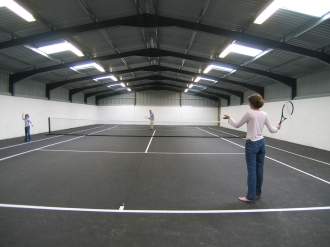
- Closely resembles the proposed facility -
(A pre-engineered steel building)
ERIC KRAUSE
In
business since 1996
- © Krause House
Info-Research Solutions -
FUNDING REQUEST TEMPLATE

- Closely
resembles the proposed facility -
(A pre-engineered steel building)
"We Are Shovel Ready and Eager To Build"
TO: .........................
FROM: Eric Krause
Chair
Cromarty Community Indoor Tennis Centre (CCITC)
ccitc@cromartytennis.ca
]Defunct]
Mailing Address:
62 Woodill St, Sydney, N.S.
B1P 4N9
(902) 539-3115
DATE: February 3, 2009
Hi:
I am sending you a description (details below) concerning the project of the CCITC, a tax-exempt Sydney-based charitable organization, registered with the Canada Revenue Agency (CRA), to build the first indoor facility in Cape Breton designed exclusively for the game of tennis.
The CCITC, a public hub resource serving the entire CBRM, will be available to the public on an affordable, first come, first served basis, but even more, will also advance education by providing tennis lessons to students as a component of a school curriculum, and by offering training courses for tennis coaches, officials and instructors. It will also relieve conditions associated with aging by providing tennis programs for the aged; and it will afford relief to persons with disabilities by developing and implementing tennis programmes for the disabled.
We are estimating that our tennis facility, which will be located in a pre-engineered steel building of our construction at the Sydney Airport Authority (with hook-ups for sewer and water available and nearby), will cost $600,000 minimum to erect and place in operation. At the Sydney Airport site we have negotiated a 25-year (renewable) lease on favourable terms.
Below, please find details concerning our project:
I History
II Mission Statement
III Proposed Building - Short Version
IV Some Assessment Factors
1. Increased Sport and Physical Recreation Opportunities"
2. Community Benefit/Impact
3. Needs Assessment
4. Project Planning
5. Long Term Sustainability
6. Resourcefulness
7. Our Commitment
V Class C Estimate
VI Projected Yearly Operational Revenues and Expenses
I
HISTORY
On May 16, 2006, the Cromarty Tennis Club (founded 1902) passed a supportive motion encouraging the creation of a non-profit society to be known as the "Cromarty Community Indoor Tennis Centre" (CCITC). As an autonomous entity the CCITC exists independent of the Cromarty Tennis Club in all aspects including financial and organizational.
A second motion of the Cromarty Tennis Club then suggested that the CCITC seek charity status with the Canada Revenue Agency (CRA), and on February 12, 2008 the CRA granted its request. Upon receiving this standing, the CCITC sought out land within the CBRM.
On December 15, 2008, after an exhaustive search which ultimately led the Centre to the Sydney Airport Authority, also a non-profit community-minded Society, its Board granted a request for a long term property lease.
Following that, on January 14, 2009, the Public Services Committee of CBRM council gave its full support to the CCITC and its announced project.
II
MISSION STATEMENT
For the Cromarty Community Indoor Tennis Centre (CCITC) to raise funds to construct, maintain, and operate Cape Bretonís first indoor facility (one doubles court) designed only for tennis. An all-season operation, the Centre will feature programmes that without exception will be CCITC run and designed. Where practical, that design will meet Tennis Nova Scotia, or Tennis Canada standards.
Built exclusively for the benefit of the public, with a particular focus on the young, old, and the challenged, the Centre will provide a summer/winter playing venue for all levels and ages of tennis players, from novice through seasoned. It will encourage high public user participation rates through an affordable hourly rate - first come, first serve - and educational group clinics. It will stress that its cushioned court is state-of-the-art and exceptionally physically friendly, to draw in the older player who might hesitate to participate otherwise. An inside walking track will also be available.
The CCITC has undertaken its charity donation drive online (CanadaHelps.org) and is issuing official receipts which will ensure that eligible donors will benefit from all the tax incentives associated with gifting to a registered charity. Income tax receipts will be issued immediately.
III
PROPOSED BUILDING - SHORT VERSION
|
|
- Closely resembles the proposed facility -
(A pre-engineered steel building)
The prime goal of the CCITC is to ensure the successful construction and the on-going operation of a public indoor tennis facility, while meeting all of the charitable and ancillary activities as described in the seven objects of the Society. For a $600,000 capital investment, the minimum amount necessary to achieve the prime goal, the facility would take a certain basic, cost-effective, form. Naturally, a greater investment would produce additional enhancements, such as a larger building, extra tennis courts, full running track, year-round air-conditioning, etc.
The proposed building, located at the Sydney Airport Authority (with nearby sewer and water for our site readily available), will serve up the standard four walls, a white ceiling, indirect green court lighting, a superior insulated green envelope, an economical green heating system, basic washroom facilities (attached), and a first class alternate-style cushioned tennis court as follows:
- Note: A maximum of six progressive children's (ages 5-7, 7-9 and 8-9 year olds) practice courts will be set upon the standard-sized cushioned doubles court as required
- Note: A cushioned walking track will circle the interior perimeter
- Note: Spectator arena seating available around the interior perimeter for viewing events
The CCITC will be located within easy school bus distance from every educational institution, close to all urban and rural communities by automobile, and adjacent to a scheduled public bus service with plans for a future stop directly at the facility. Some distance examples:
IV
SOME ASSESSMENT FACTORS
1.
"Increased Sport and Physical Recreation Opportunities"
To wit:
(1) The improvement of sport and recreation opportunities for all residents of the CBRM
(2) Gender equity to increase the participation of girls and women in sport and recreation
(3) The building of healthier communities
(4) The construction of a facility for public recreation
(5) The reflection of the recent trends (healthy living), activity patterns (physical activity) and the shifting demography (aging population) of the CBRM
(6) The promotion of the Province of Nova Scotiaís Active Kids, Healthy Kids strategy
(7) The encouragement of fair and safe play
___________________________________________
2.
"Community Benefit/Impact"
The Cromarty Community Indoor Tennis Centre (CCITC), an approved Canada Revenue Agency (CRA) charity is presently raising funds to construct, maintain, and operate Cape Bretonís first indoor facility (one covered doubles court) designed exclusively for tennis. It will be located at the Sydney Airport Authority (a non-profit society). The proposed building is described in detail at http://www.cromartytennis.ca/ccitc/CCITCBuildingShortV.html . [Defunct Site - See Cromarty Community Indoor Tennis Centre - Proposed CCITC Public Indoor Tennis Facility]
Built exclusively for the benefit of the public at large, and serving as a hub facility for the entire CBRM, the CCITC will place a particular focus on the young, the old, the challenged, and those unfamiliar with the game of tennis. It will provide a summer/winter, healthy lifestyle playing venue for all levels and ages of tennis players, from novice through seasoned. It will encourage high public user participation rates through an affordable hourly rate - first come, first serve - and educational group clinics. It will stress that its state-of-the art cushioned court is exceptionally physically friendly, to draw in the older and challenged player who might hesitate to participate otherwise.
The Centre will stress public instruction, at both an hourly and clinic level. At the hourly level, CCITC trained local staff will provide tennis advice, knowledge, practical tips, and even racquets upon the asking, at no additional charge.
In addition, the Centre will target the younger public, through assorted winter and summer group clinics. It will maximize the number of operating hours to what is practical. In particular, the Centre will concentrate on winter school, winter after school, and winter junior development programmes based on Tennis Canada training, instructional, and skills upgrading criteria. Winter coaching clinics would be another priority, as would other community group initiatives, such as wheelchair and mixed senior (plus 55) play.
Our Charity Goals
The following organizations have provided particular support:
(1) Two supporting motions of the Cromarty Tennis Club (A separate organization from the CCITC, founded in 1902), May 16, 2006 - (Cromarty Tennis Club, PO Box 746, Sydney, NS B1P 6H7. Contact: Pat Johnston, President, patj@eastlink.ca )
Clearly the executive of this fair-weather outdoor membership-based facility were enthralled with the possibility of an all-weather indoor public facility completely separate in finance and organization from itself, yet of great benefit to them in particular and, like themselves, to the community at large.
(2) Motion of the Board of the Sydney Airport Authority, Board of Directors, December 15, 2008 - (Sydney Airport Authority, P.O. Box 670, Sydney, Nova Scotia, Canada, B1P 6H7. Contact: Lawrence MacPherson, CEO, larrymceo@sydneyairport.ca )
In its own words when describing another onsite initiative, "This partnership fulfills the Sydney Airport Authorityís commitment to make the airport a community resource that provides economic development opportunities for all concerned."
(3) Endorsement of support from the Public Services Committee, January 4, 2009 - (Cape Breton Regional Municipality, 320 Esplanade, Sydney, Nova Scotia, B1P 7B9), Contact Fred Brooks, ftbrooks@cbrm.ns.ca )
No doubt the CBRM sees our project as a complementary development that will much enhance their own recreation & community mandate as well one that would be eligible for support of "not-for-profit community organizations within the Cape Breton Regional Municipality (CBRM) to develop, construct, renovate, conserve and maintain community facilities for public recreation."
___________________________________________
3.
"Needs Assessment"
As Cape Bretonís first indoor facility designed only for tennis, the CCITC will increase the physical activity and overall well-being and health of an island population within an unique setting hitherto only available on the mainland and elsewhere in Canada. Thus, while inclusive of all, yet focusing on the young, the old, and the challenged, the facility will also emphasize, in its design and programming, an enhanced accessibility (including wheelchair access).
The CCITC will stress physical activity amongst a client base clearly in need of public direction, will mobilize a community looking desperately for increased infrastructure capacity, provide a safe environment in an ever dangerous world, increase public awareness of the need for physical activity, and provide proof that its programming has beneficial personal and community outcomes.
The possibility is real that a popular CCITC (one court), given its relatively inexpensive capital outlay, would spawn satellite facilities (one court) in other local communities within the CBRM. The distance required to travel to the first CCITC might raise this demand. Clearly, the executive of the CCITC would encourage such an outcome.
In the past, arrangements for winter tennis - be it by the Cromarty Tennis Club, or private members initiative - whether in warehouses in Sydport or on the North Side, or at CBU, drew substantive numbers of players of all ages. Willing as they were to play in makeshift surroundings, these locations represented a clear need and crying out for a proper facility. In particular, they speak to an aging Cape Breton population seeking physical experience as a significant life choice on an island where such choices are limited, relative to other Canadian places.
___________________________________________
4.
"Project Planning"
The following from the local community have been very helpful to our planning process:
(1) Malcolm Gillis, CBRM - Advice/support
(2) Jamie F. Gillis, CBRM - Advice/support
(3) Fred Brooks, CBRM - Advice/support
(4) Frank Bruleigh, CBRM - Advice/support
(5) Wayne Lattimer, Contractor - Advice
(6) Larry MacPherson, Sydney Airport Authority - Advice/support
(7) Aubrey Farrow, Grand Lake Road Vol. Fire Dept. - Advice
(8) John Astephen, Cape-Breton-Victoria Regional School Board - Advice/support
(9) Hayes MacNeil, Board of Governors, Cape Breton University - Advice/support
(10 Bill Buckland, National Senior Representative for Nova Scotia, Tennis Canada - Advice/support
(11) Eric Krause, Krause House Info-Research Solutions - Involvement/support
(12) Tom Wilson, Councilor - Advice/support
The construction schedule and the project management are as follows:
(1) Six to eight weeks "shovel ready" following our meeting of funding and local code requirements. Project management selection is pending a 2009 successful tender
(2) A number of companies (including additional local ones have been contacted and we are presently awaiting their estimates) have provided ball-park Class C estimates of cost (see further on) and their expected construction schedules:
(i) Wayne Lattimer, Sydney - Slab work and building assembly
(ii) Richard Chapman, Eascan Building Systems (Eastern Canadian Structures Ltd) - Building and insulation package
(iii) Jack Evans, Olympia Steel Buildings - Building and insulation package
(iv) Matt Auffrey, Playteck, NB (Cushion tennis court construction)
(v) Kevin Cornish, Maine Tennis and Track (Cushion tennis court construction)
Funding in place is as follows:
(1) Fundraising and donations - A CCITC Bank account has been established. In 2009 contributions have been received at (http://www.canadahelps.org/ and distributed to our account
(2) Donated materials, equipment, and donated volunteer labour (in-kind ) - We expect a considerable amount of "in-kind" labour and materials from some of the long-term members of the Cromarty Tennis Club who are also successful business owners.
(3) Charitable sponsorship donations - We shortly expect one major announcement. Also, upon receipt of any Federal or Provincial funding, we will be actively soliciting matching corporate funds. We also expect funds from the naming rights to the facility as well as to the unique tennis court itself.
(4) Provincial Funding (Pending 2009)
(5) Federal Funding (Pending 2009 - Recreation Infrastructure Canada (RInC))
(6) Municipal Funding (Pending 2009)
___________________________________________
5.
"Long Term Sustainability"
Although the CCITC has existed since only 2006, the Cromarty Tennis Club (CTC), whose members the CCITC will draw upon for their experience, proven volunteerism and participation, has been an uninterrupted success in Sydney since 1902. Their list of accomplishments, which are legendary, has included a strong, sustainable annual, summer outdoor after-school and junior programme. They also support a growing retiree and friends programme that encourages outdoor tennis play throughout the year (including the winter months when possible) for the older player. Clearly the Cromarty Community Tennis Centre will be a valuable asset to which the membership of CTC and other CBRM tennis clubs will turn, particularly during the winter and inclement days.
The Cape-Breton-Victoria Regional School Board has developed a very successful healthy life styles programme with Ski Ben Eoin that is linked to its physical education curriculum, in which they stress it important that children participate. We have been advised that our facility could receive the same treatment once our structured programme is in place. This is because it will stress the same goals and even more, and also is inclusive of physically challenged children. As at Ben Eoin, there would be a cost recovery charge-back to the participant.
Since the design of the facility meets Tennis Canada standards, and as well has room for perimeter seating, it will encourage exhibition matches involving professionals in support of our charity programmes. For example, the "Raising a Racquet for Kids" is an annual fundraiser where for example current world doubles #1 player, Daniel Nestor & rising Canadian star, 20 year old Peter Polansky have appeared.
Another example is where Tennis Canada is mandated "to lead the growth, promotion and showcasing of the sport of wheelchair tennis in Canada, build a system that helps produce world class players, and foster the pursuit of excellence for all. " As a consequence, Tennis Canada recognizes the impact a tennis chair has on the enjoyment of challenged players and on the general progression in the sport, and thus has a lending programme to provide quality used tennis chairs to programs such as ours.
Our facility also includes an interior walking track which will attract another type client during the winter months.
This facility is also new, and comes with a number of long-term warranties. For example, the structure itself comes with 25 and 50-year warranties.
Revenues will certainly support at least one full time manager, and one part-time assistant, with an array of volunteers available to lessen the load and provide expertise training.
List of some of the community organizations that will use the facility:
(1) Cromarty Tennis Club
(2) Sydney River Tennis Club
(3) Glace Bay Tennis Club
(4) New Waterford Tennis Club
(5) North Sydney Tennis Club
(6) Cape-Breton-Victoria Regional School Board
(7) Cape Breton Island Hoppers Volksmarch Club
In other words, long term sustainability will not be a problem.
___________________________________________
6.
"Resourcefulness"
The list of public, not-for-profit, and private partners that in particular support the CCITC project are as follows. Included below are their contributions and the nature of the agreement between each of them and the CCITC:
(1) Sydney Airport Authority: 25-year, renewal lease on favourable terms
(2) Cromarty Tennis Club: Volunteers for CCITC programmes
(3) Krause House Info-Research Solutions: Volunteer for current building construction research, report production, and maintenance of the present Web Site ( http://www.cromartytennis.ca/ccitc/ - Defunct Site]
(4) We also expect a considerable contribution for the naming rights to the facility.
___________________________________________
7.
"Our Commitment"
The internal commitment of the CCITC will certainly be strong.
(1) Pending upon the approval of the construction of the building - Up to one-third of the total project cost would be a reasonable goal.
(2) Pending upon the approval of the construction of the building - We expect a considerable amount of "in-kind" labour and materials from some of the long-term members of the Cromarty Tennis Club who are also successful business owners.
V
CLASS C ESTIMATE
Proposed Building and Tennis Court - At The Sydney Airport Authority
(1) Consulting Fees - $00,00
(2) Site preparation and concrete reinforced slab on grade with frost wall for the main building, plus a slab for a small washroom as an appendage - $100,000
(3) A "pre-engineered rigid framed" steel building, 80' wide x 140' long, with c. 26' high side walls and c. 39' to a central ridge, with a 5:12 roof pitch - $240,000
(4) Building Assembly - $60,000
(5) Superior "green" insulation (Walls R20, ceiling R40) with either indirect ventilation through ceiling-mounted exhaust fans or natural infiltration - $70,000
(6) Propane gas-fired high-intensity infrared radiant ceramic ["light"] "green" heating system (One Modine MT 120 set at each end of the building) maintaining a 55 F degrees [12.7 degrees C] inside winter temperature - $8,000
(7) Electrical utilities and installation of T5 fluorescent blue light technology: 18 ten-lamp T5HO [high Intensity] Fluorescent indirect light fixtures (Courtlite Direct Recreational energy efficient "green" lighting system) - $12,000
(8) Basic washroom amenity (appendage) connected to nearby water and sewer - $15,000
(9) An automatic active fire suppression system - $20,000
(10) Security and fire monitoring system- - $10,000
(11) One, state of the art, cushioned, doubles court measuring overall 60' x 120' centred upon a cushioned area measuring 80' x 140' - $35,000
(12) Miscellaneous (Lawyer fees, insurance, permits, landscaping, tennis building furnishings/fittings/equipment) - $30,000
Total: $600,000
Note: A successful tender on a turnkey facility (but not including the tennis court) might produce a measurable savings in cost. Also, we expect some savings in some in-kind volunteer labour and materials from the local business community.

(Closely
resembles the proposed facility)
_________________________________
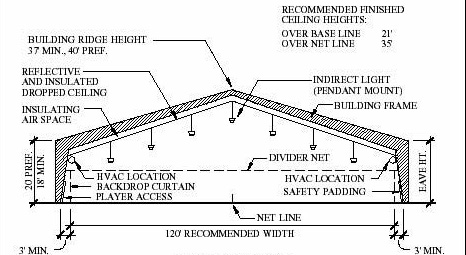
_________________________________
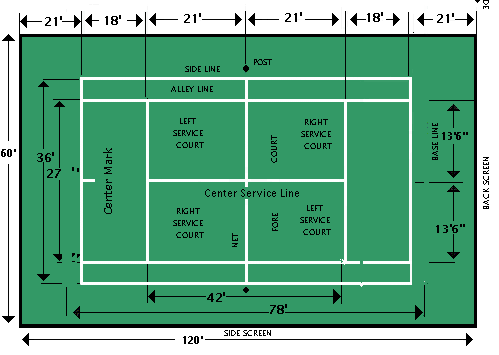
http://www.novasports.com/tencrt.htm
|
|
_________________________________ Several
examples of possible state-of-the-art cushioned surfaces NOVA SPORTS:
http://www.novasports.com/products_NOVACUSHION.htm
/
A shock absorbing feature that provides players with a firm playing surface, that reduces the risk of pulling muscles or twisting ankles, that is less traumatic on joints than traditional surfaces, and that is a superior health alternative for participants of all ages. |
AERIAL ONE: SYDNEY AIRPORT AUTHORITY LOCATION
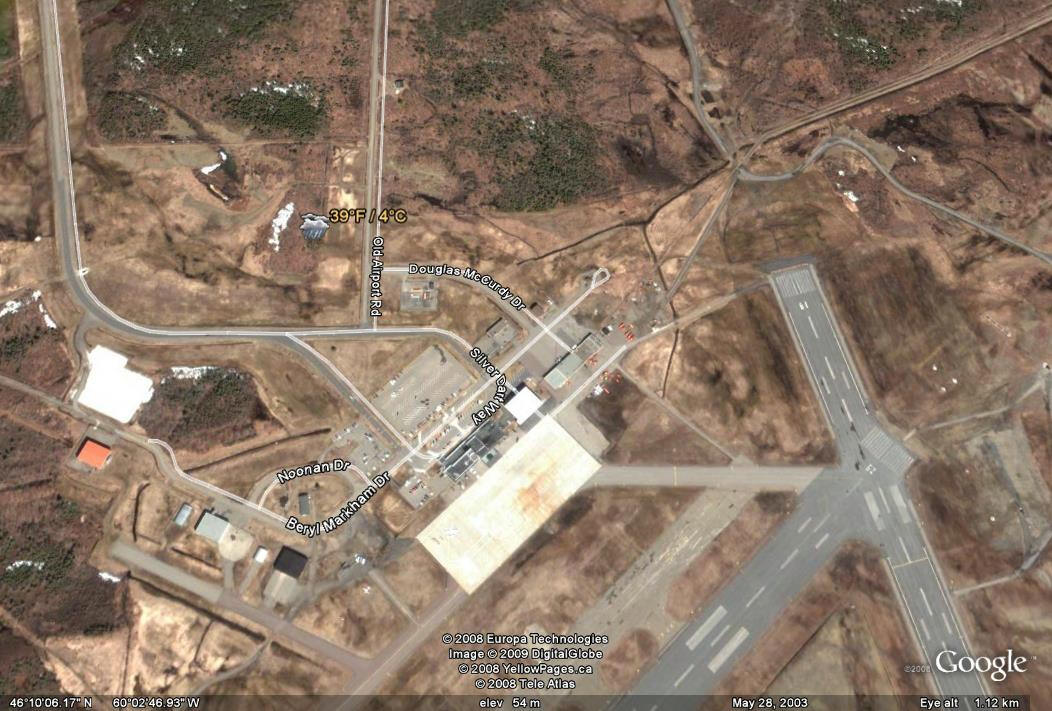
___________________________________________
AERIAL TWO: SYDNEY AIRPORT AUTHORITY LOCATION
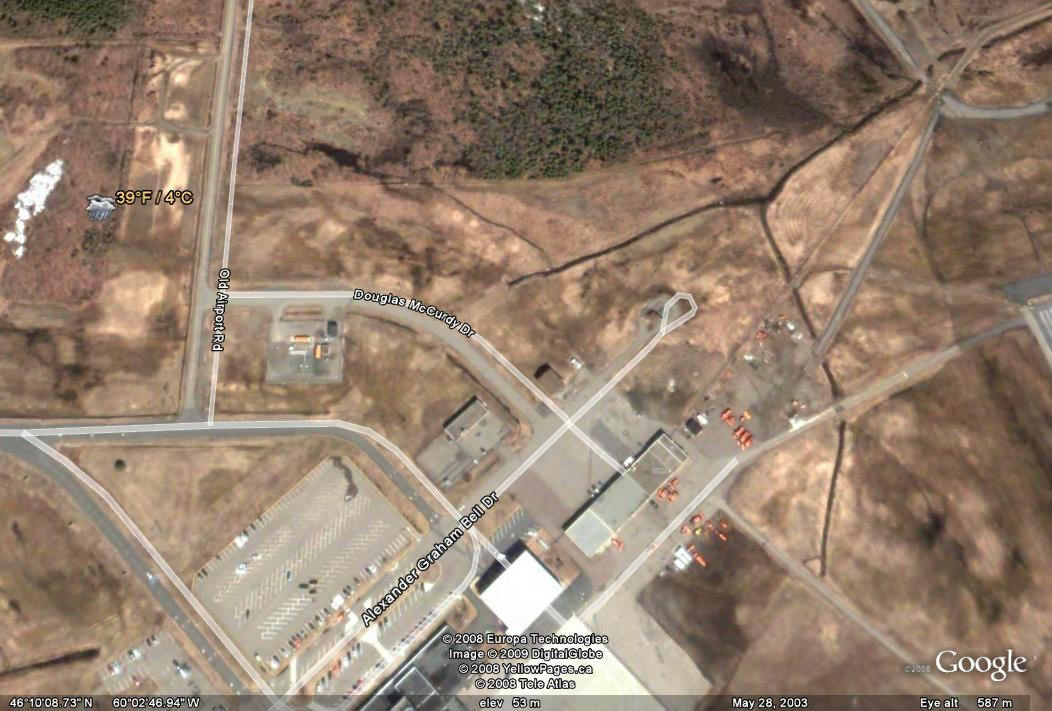
PROJECTED YEARLY OPERATIONAL REVENUES AND EXPENSES
(1)
Revenues
Revenue Projections, Source of Funding, and Profitability Analysis
The goal of this public facility is to generate sufficient revenue to cover off a 12-month operating expense of lights, heat, security, maintenance and staff. This building will not incur any initial amortized capital costs.
(A) Maximum Revenue Stream Possible
Maximum revenue projections could be based on a 360 year 17-hour day player operation, or 6120 operational hours per year, with the user fee rooted in singles and doubles play. For example:
(1) 17 hours per day x 360 days x 4 players would generate 24,480 summer-winter player hours
(2) 17 hours per day x 360 days x 2 players would generate 12,240 summer-winter player hours
(3) 17 hours per day x 208 days x 4 players would generate 14,144 winter player hours
(4) 17 hours per day x 208 days x 2 players would generate 7,072 winter player hours
(5) Any combination based on the above
In this scenario, a profitability analysis would need to consider that all of these hours would incur an hourly player-required lighting cost. Furthermore, the 208 17-hour winter playing days (November 1-May 31) would attract 3536 of player-required heating costs, with another 1456 hours of building-required heating costs when the public facility was not operational late at night and early in the morning (i.e. 7 additional hours per day).
(B) Proposed Revenue Stream
A reasonably priced November 1-May 31 winter programme just by itself would offset total yearly operational costs, and that any funds generated by a summer indoor programme (June 1 - October 31) would be gravy. For example, during the winter session, the number of available hours (less 4 storm days) would be as follows:
(1) Prime Time (1571 hours or 53 hours per week) - Non-Retired Players Have Priority
(i) Every night: 6 pm-11 pm - 5 hours x 208 days or 1040 hours
(ii) Weekend days: 9 am-6 pm - 9 hours x 59 days or 531 hours
(2) Off-Hours (1341 hours or 45 hours per week) - Retired and Non-Retired Players have Equal Priority
(i) Week Days: 9 am-6 pm - 9 hours x 149 days or 1341 hours
Clearly, given a reasonable per hour charge, one would expect prime hours to be fully booked and off-hours booked to a lesser degree. Adding the actual results of the two bookings together, a winter court fee as low as $10.00 per hour (and certainly $20.00) could conceivably meet all operational obligations for the entire year!
From a player's perspective, a low winter hourly charge would encourage multiple sessions per week (whether singles or doubles), whereas a higher charge would obviously discourage both multiple per-week and singles play.
(C) Fees
The Centre will charge an hourly, tennis booking fee, first come, first serve, at all times excepting when the Centre is meeting its charity community tennis mandate with these programmes pre-scheduled on its website.
The summer outdoor operation at the Cromarty Tennis Club has successfully sustained itself now for many years with a relatively low membership fee, with an active volunteer participation, and with some key staffing grants. The summer indoor public facility (which will utilize hourly rather than yearly membership fees) should have a similar goal in mind - i.e. low hourly rates, active volunteers, staffing grants.
In the winter, highly motivated recreational and competitive players, as well as large playing families - competing over one court - will want two to three sessions per week. In essence, this is a multiple participation use that must be encouraged through an affordable hourly rate.
An economically-sound indoor user regime might then take the following format:
(1) Public Indoor Winter Programme (November 1 Ė May 31)
Clearly, operational charges will be higher during the winter months and the fee will need to reflect how best to recoup costs. A realistic per-hour user charge (i.e. based on 60 minutes, not 40 minutes, not 90 minutes, etc.) would probably best meet this requirement.
Player fairness would be ensured through an on-line internet booking system .
As already noted above, the number of available prime time hours per week would be 53 with non-retired players having a priority. Another 45 hours per week would be available to retired and non-retired players during the off-times.
(2) Public Indoor Summer Programme (June 1-October 31)
During the summer months public participation would no doubt fall off due to the wide variety of competing recreational activities including outdoor tennis. To encourage the participation of outdoor tennis clubs in the area, as well as the public in general (including the travelling visitor), a lower fee (i.e. based on 60 minutes, not 40 minutes, not 90 minutes, etc.) would be charged for those wishing to use the public facility.
A paper on-site booking system during the summer would be best as this would assure both planned as well as spontaneous play (e.g. when the outdoor courts were fully occupied, or when visitors arrived).
(D) Cost-Recovery Winter School, After-School, and Junior Development Tennis Programmes
A winter school tennis programme should be designed as an option for those now using the existing Ski Ben Eoin school programme. For example, youth/school ski program rates there range from a weekend charge of $27.00 for a lift pass, lesson and rental to a $3.00 charge for a midweek lesson only. In particular, the tennis programme should concentrate on midweek bookings so as not to intrude upon the more popular tennis weekends. During this midweek period, the ski program charges $20.00 for a lift pass, lesson and rental and $3.00 for a lesson only, fees with which a public indoor facility could easily compete.
A separate winter "after-school" tennis programme modeled upon the Cromarty Tennis Club's summer one might be quite popular as well.
A winter junior development programme, separate from the above school programmes, designed to fast-track the CBRM's best players to national prominence is a must. Presently these players are at a national disadvantage during winter months as they have no place to maintain and increase their skills.
Within the cost-recovery aspect of the winter school programme, there would certainly be sufficient funds to entice a retired player(s) as manager/instructor and a part time assistant manager/Instructor to provide the required lesson and supervisory component; Similarly there would be enough for a stipend to entice a local players of a national calibre to provide the required lesson and mentor component for a junior programme.
(E) Extraordinary Club Closed Programmes
Specialized programmes designed to raise Cromarty Community Indoor Tennis Centre money (e.g. private lessons, exhibition tournaments, etc.) would not be deterred by the whims of weather and could thus be quite appealing because of the certainty of an event being held.
(F) Alternate Uses
Other groups, such as yoga, are known to be looking for an inexpensive, reliable public facility where to hold their programmes.
(G) Yearly Operating Grants
The Province or CBRM might be willing to match the summer grant amount for a winter programme if it included a junior and school programme.
Any winter fitness programme that the Cromarty Community Indoor Tennis Centre might run during the winter in association with schools might be eligible for a provincial or federal grant, now or in the future.
(H) Donations and Bequests
Tax deductible donations and bequests are now possible throughout the year since the Centre is a registered non-profit charity.
(I) Corporate Sponsorships
Sponsorships are an integral part of the marketing and promotional activities of many companies, including RBC which promotes amateur sports.
_________________________________
2.
Expenses
Expense Projections
Note: A Yearly Operating and Staff Grant(s) Could Reduce Overall Costs
|
Line Item |
Details |
Estimated Cost |
|
|
||
| Lighting | - T5 fluorescent blue light technology |
$1.00 per hour |
| Heating | - Infrared Ceramic |
$5.00 per hour |
| Building Maintenance | - Pre-engineered |
Minor |
| Court Maintenance | - Cushioned Court |
Minor |
| Heating System Maintenance | - Infrared Ceramic |
To Be Determined: Maintenance Contract Required |
| Fire Suppression | - To Be Determined |
To Be Determined: Maintenance Contract Required |
| Security and Fire Monitoring | - To Be Determined |
To Be Determined: Maintenance Contract Required |
| Insurance | - Property |
To Be Determined |
| Insurance | - Third-Party |
$2,000.00 |
| Insurance | - Director & Officers Liability (Wrongful Acts) - $2,000,000.00 coverage |
$1,500.00 |
| Staff | One full time retired manager/instructor, and one part-time retired assistant manager/instructor, with an array of volunteers available to lessen the load. |
Wage to depend upon revenues |